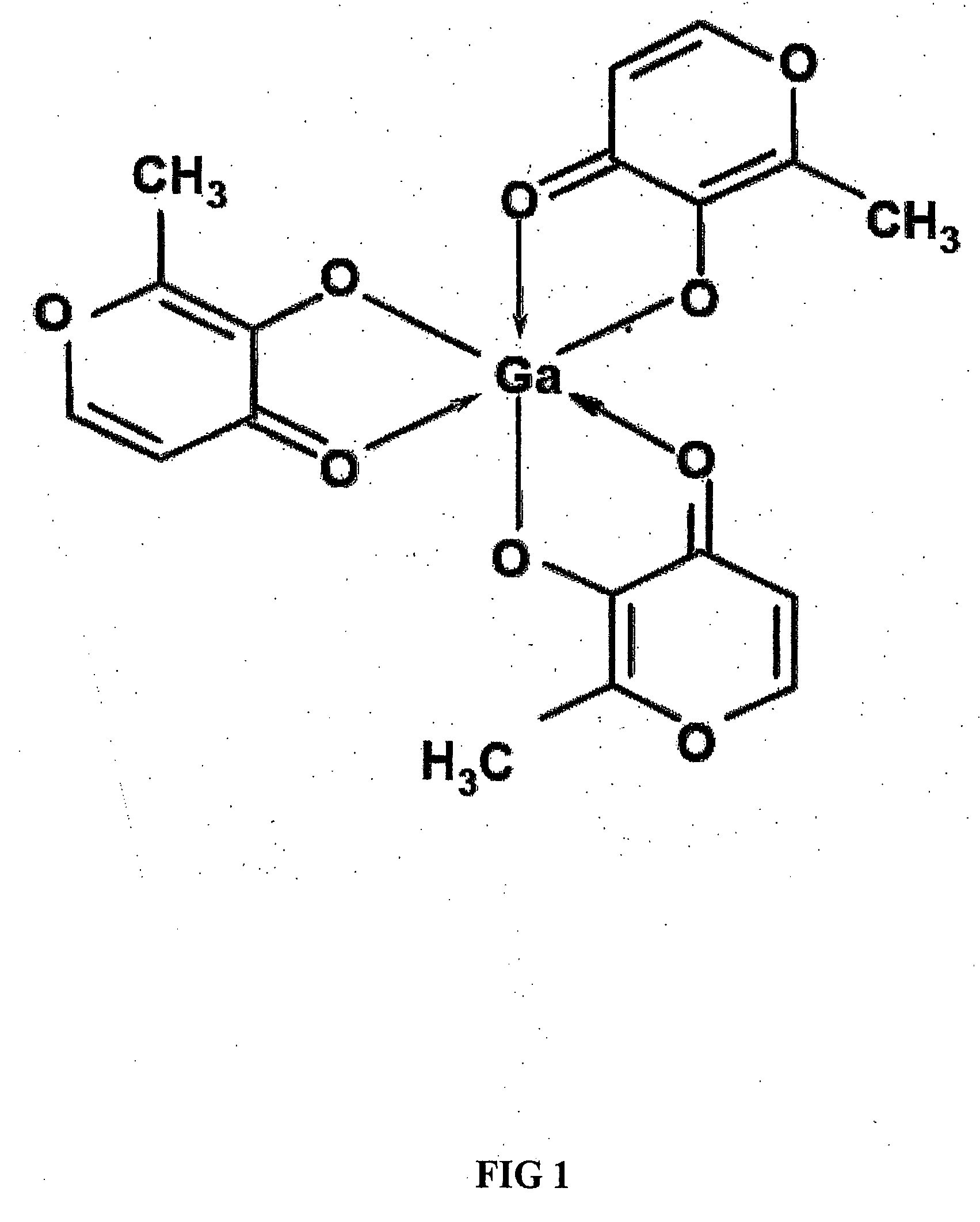Method of treating gallium-nitrate resistant tumors using gallium-containing compounds
- Summary
- Abstract
- Description
- Claims
- Application Information
AI Technical Summary
Benefits of technology
Problems solved by technology
Method used
Image
Examples
example 1
Inhibition of CCRF-CEM Cell Growth by GaM is Due to Gallium and not Maltol
[0061]CCRF-CEM cells were plated at a density of 2×105 cells / ml in microwell plates (100 μL cell suspension per well) in the presence of increasing concentrations of gallium maltolate or maltol (subsequently referred to as the additives). After 72 h of incubation, 10 μL MTT (3-(4,5-dimethlythiazol-2-yl)-2,5-diphenyltetrazolium bromide) was added to each well and the incubation continued for 4 h at 37° C. Cells were then solubilized by the addition of 100 μL of 0.4 N HCl in isopropanol to each well and the absorbance of each well was read at 570 nm using a microplate reader. The effect of the additives on cell proliferation was determined by comparing the absorbance from wells containing the additives with the absorbance from wells in which the additives were omitted (decreased absorbance signifies decreased cell proliferation). Cell growth was expressed as a percentage of control (cell growth in the absence of...
example 2
Comparative Effects of GaN and GaM in Mantle Cell Lymphoma HBL-2 Cells
[0062]HBL-2 cells were plated at a density of 2×105 cells / ml in microwell plates (100 μL cell suspension per well) in the presence of increasing concentrations of GaM or GaN (referred to as the additives). After 72 h of incubation, 10 μL MTT (3-(4,5-dimethlythiazol-2-yl)-2,5-diphenyltetrazolium bromide) was added to each well and the incubation continued for 4 h at 37° C. Cells were then solubilized by the addition of 100 μL 0.4 N HCl in isopropanol to each well and the absorbance of each well was read at 570 nm using a spectrophotometer. Cell proliferation was measured after a 72 h incubation period.
[0063]The effect of the additives on cell proliferation was determined by comparing the absorbance from wells with the additives with the absorbance from wells in which the additives were omitted (decreased absorbance signifies decreased cell proliferation). Cell growth was expressed as a percentage of control (cell g...
example 3
GaM Activates Caspase-3 at Lower Gallium Concentrations than GaN in HBL-2 Cells
[0064]HBL-2 cells were incubated with increasing concentrations of GaM or GaN for 48 h. After incubation with these compounds, the cells were analyzed for apoptosis using the commercially available apo-One™ assay that measures caspase-3 activation. Data points are the means and S.E. of an experiment performed in triplicate. The experimental results depicted in FIG. 4 show that caspase-3 is activated with GaM but not with similar concentrations of GaN.
PUM
| Property | Measurement | Unit |
|---|---|---|
| Mass | aaaaa | aaaaa |
| Mass | aaaaa | aaaaa |
| Mass flow rate | aaaaa | aaaaa |
Abstract
Description
Claims
Application Information
 Login to View More
Login to View More - Generate Ideas
- Intellectual Property
- Life Sciences
- Materials
- Tech Scout
- Unparalleled Data Quality
- Higher Quality Content
- 60% Fewer Hallucinations
Browse by: Latest US Patents, China's latest patents, Technical Efficacy Thesaurus, Application Domain, Technology Topic, Popular Technical Reports.
© 2025 PatSnap. All rights reserved.Legal|Privacy policy|Modern Slavery Act Transparency Statement|Sitemap|About US| Contact US: help@patsnap.com



